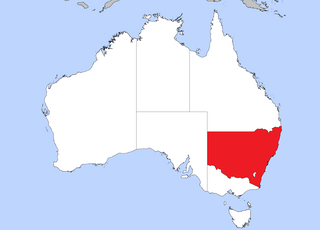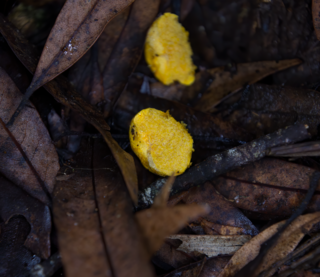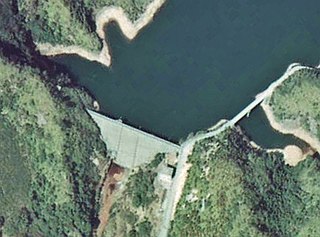Related Research Articles

The Boletaceae are a family of mushroom-forming fungi, primarily characterised by small pores on the spore-bearing hymenial surface, instead of gills as are found in most agarics. Nearly as widely distributed as the agarics, the family is renowned for hosting some prime edible species highly sought after by mushroom hunters worldwide, such as the cep or king bolete . A number of rare or threatened species are also present in the family, that have become the focus of increasing conservation concerns. As a whole, the typical members of the family are commonly known as boletes.

Macrolepiota is a genus of white spored, gilled mushrooms of the family Agaricaceae. The best-known member is the parasol mushroom (M. procera). The widespread genus contains about 40 species.
Barcheria is a fungal genus in the family Agaricaceae. This is a monotypic genus, containing the single sequestrate species Barcheria willisiana, found in western Australia.
Heliogaster is a sequestrate genus of fungi in the family Boletaceae. This is a monotypic genus, containing the single species Heliogaster columellifer, found in Japan. The genus was first described in 2010, to accommodate the species formerly named Octaviania columellifera by Kobayasi in 1937.
Mackintoshia is a fungal genus in the family Boletaceae. It was originally placed in Cortinariaceae. The genus is monotypic, containing the single truffle-like species Mackintoshia persica, found in Zimbabwe. This fungus, eaten by both the common duiker and the Karanga people, is little known outside the Midlands Province of Zimbabwe. Mackintoshia was circumscribed by Giovanni Pacioni and Cathy Sharp in 2000. The genus name honors British-Rhodesian farmer Robbie Mackintosh, who collected and documented some early specimens. The specific epithet persica is Latin for peach, referring to its odor.

Octaviania is a genus of truffle-like fungi in the family Boletaceae. The widespread genus is estimated to contain 15 species.

Thaxterogaster argyrionus is a species of sequestrate (truffle-like) fungus in the family Cortinariaceae. Described as a new species in 2010, it is known only from New South Wales.

Phlegmacium basorapulum is a species of truffle-like fungus in the family Cortinariaceae. Found in New South Wales, Australia, the species was described as new to science in 2010.

Thaxterogaster caesibulga is a species of truffle-like fungus in the family Cortinariaceae. Found in New South Wales, Australia, the species was described as new to science in 2010.

Thaxterogaster cinereoroseolus is a species of truffle-like fungus in the family Cortinariaceae. Found in New South Wales, Australia, the species was described as new to science in 2010.

Thaxterogaster nebulobrunneus is a species of truffle-like fungus in the family Cortinariaceae. Found in New South Wales, Australia, the species was described as new to science in 2010.

Rossbeevera is a genus of sequestrate (truffle-like) fungi in the family Boletaceae. It was first published in 2012 under the erroneous name Rosbeeva, but was corrected to Rossbeevera in the same issue. The genus was created to contain species formerly placed in Chamonixia, but characterized by having ellipsoid to spindle-shaped spores with 3–5 longitudinal ridges, bluish-green to deep blue fruit body staining reaction, and a thin whitish peridium. The Chinese species R. yunnanensis is the earliest diverging lineage within the genus, and has a close phylogenetic relationship with the bolete genera Turmalinea and Leccinellum.

The Boletineae are a suborder of the fungal order Boletales. Families in the Boletineae include the Boletaceae and the Paxillaceae.
Ross Ewen Beever was a New Zealand geneticist and mycologist.
Solioccasus is a fungal genus in the family Boletaceae. It is a monotypic genus, containing the single Australasian species Solioccasus polychromus. This is a truffle-like species with a roughly spherical to lobed fruitbody, which measures up to 4.5 cm (1.8 in) in diameter. It is initially dull white, but becomes yellow to pink to orange to red in maturity, making it one of the most brightly colored hypogeous species known.

Stephanospora is a genus of truffle-like gasteroid fungi in the order Agaricales. In 2014, nine new Australasian species were described from collections previously thought to represent S. flava.

Rossbeevera griseobrunnea is a species of the fungal family Boletaceae. This species was first described in April 2019 from southern China.
Dr Teresa Lebel is a taxonomist and ecologist who works on fungi, with a particular interest in subterranean truffle-like fungi and their mushroom, bolete, bracket or cup relatives.
Russula agaricina is a fungus in the family, Russulaceae.

Arita Dam is a gravity dam located in Saga Prefecture in Japan. The dam is used for flood control and water supply. The catchment area of the dam is 2.2 km2. The dam impounds about 18 ha of land when full and can store 1880 thousand cubic meters of water. The construction of the dam was started on 1958 and completed in 1961.
References
- ↑ Lebel, Teresa; Orihara, Takamichi; Maekawa, Nitaro (1 January 2011). "The sequestrate genus Rossbeevera T. Lebel & Orihara gen. nov. (Boletaceae) from Australasia and Japan: New species and new combinations". Fungal Diversity. 52 (1): 49–71. doi:10.1007/s13225-011-0109-x. ISSN 1560-2745. S2CID 1084651 . Retrieved 6 May 2019.
- ↑ Orihara, T.; Lebel, T.; Ge, Z.-W.; Smith, M.E.; Maekawa, N. (2016). "Evolutionary history of the sequestrate genus Rossbeevera (Boletaceae) reveals a new genus Turmalinea and highlights the utility of ITS minisatellite-like insertions for molecular identification". Persoonia. 37: 173–198. doi:10.3767/003158516X691212. PMC 5315287 . PMID 28232764.